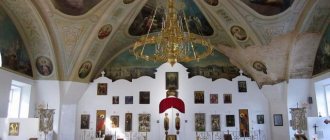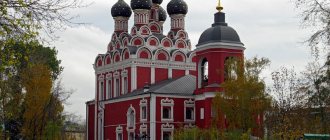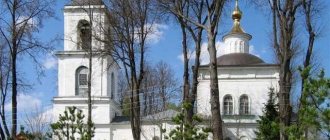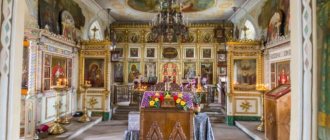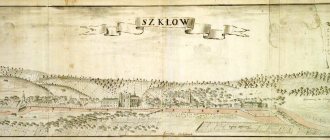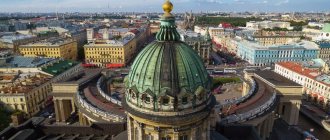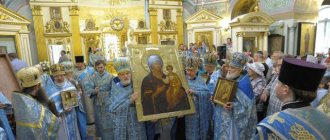Among all the gardens, mills and ponds of the village of Izmailovo, where the Church of the Intercession stands, Tsar Peter the Great spent his rather early childhood. It is believed that it was here, in one of the barns of the Linen Yard, that he found an ancient boat, which was destined to become the “grandfather of the Russian fleet.” The forgotten boot lay in the mud and was waiting for young Peter to find it.
| Church of the Intercession of the Blessed Virgin Mary in Izmail Lovo | |
| A country | Russia |
| City | Moscow |
| Year of foundation | 1680 |
| Website | https://www.hrampokrova.ru |
| Abbot | Archpriest Vladimir Bushuev |
The Church of the Intercession of the Blessed Virgin Mary in Izmailovo is an Orthodox church that belongs to the Moscow city diocese. It is located in the eastern administrative district of Moscow.
For the first time the village of Izmailovo is indicated in the scribe books for 1571
For the first time, the village of Izmailovo is indicated in the scribe books for 1571. It is believed that its dawn came during the reign of Alexei Mikhailovich in the 17th century.
The documents preserved many reports, papers, drawings that relate to the layout and structure of buildings throughout the village. It can be assumed that this is the first complex in Russia that was revived precisely according to drawings and papers.
The dawn of the village of Izmailovo came during the reign of Tsar Alexei Mikhailovich. Photo: klobukov.ru
The Church of the Intercession of the Blessed Virgin Mary in Izmailovo was built in 1680
In 1680, the Church of the Intercession was built in Izmailovo. It was built by the great masons Grigory and Fyodor Medvedev.
This is what the first entry in the scribe book says about this:
1680
this year the Church of the Intercession was built in Izmailovo
“...To make a stone church in the old village of Izmailovo, unlike the model of the cathedral church in Alexandrovskaya Sloboda, without basements, the length between the walls is nine fathoms, the same diameter, and the height of the church and altar as needed, and around that church to make three steps as necessary, but to do that church stone work will be shown to us by the apprentice...”
This is what the Intercession Cathedral in Izmailovo looked like after construction.
This is how the Intercession Church was briefly and accurately marked in a business-like manner. But it is believed that the cathedral was the most grandiose building in Russia at that time. The Intercession Cathedral in Izmailovo had a height of 57 meters, its central chapter had a height of 18 meters, which can be compared with a modern six-story building.
57
So many meters in height did the Intercession Cathedral reach
But if you pay attention, in this case we are talking only about the bulbous end, without its drum, that is, its height is even greater. You can imagine how this building delighted the residents of the 17th century.
The Cathedral of the Intercession of the Blessed Virgin Mary in Izmailovo is unique in its kind
But it was precisely the analysis of the cathedral’s architecture that made it possible to say that the builders did not fulfill the wishes of the customer. The customer wanted the Cathedral of the Intercession of the Holy Virgin in Izmailovo to be similar to the cathedral in Alexandrovskaya Sloboda. But this building is not like that temple; it turned out to be even more unique.
If you look at the church, you can see that it is adjoined on three sides by elegant porches. We can also see vertical white stone frames of double-height windows and groups of thin white columns on the façade.
The Intercession Cathedral in Izmailovo delighted and delighted the inhabitants of the 17th century. Photo: andcvet.narod.ru
The floor here has always been laid with oak blocks. Unfortunately, the five-tiered iconostasis, which was designed by the best painters, has not survived to this day.
A little more about the appearance
Next to the colorful porch of the western facade of the temple there is a stand with a description of the historical fate and events that the Cathedral of the Intercession of the Blessed Virgin Mary experienced. An unusual-looking font with curly letters presents the text in a completely modern and understandable language. Behind the stand are connected the walls of the shelter and the temple, between the construction of which there is almost a two hundred year gap.
Neither the builders of the almshouse nor the authors of the latest reconstruction began to disguise such a gap; the difference in styles and materials is obvious. The chronology of the history of the temple contains both its background and construction, including extensions. Newer buildings are plastered, smooth on the top, and grooved on the ground floor, the seams of which imitate large blocks. Against the light background of the extensions, the temple between them stands out sharply.
To the right of the main entrance, in the partition between the second and third windows of the first floor of the shelter, there is a memorial plaque cast from metal. It depicts Tsarevich Peter at a young age, holding a model of a ship in his right hand, turning his head towards the model. The edges of the board are stylized as an ancient scroll; at the bottom there is a ribbon glorifying the future emperor as the founder of the Russian fleet.
The memorial plaque was conceived and made by veterans who lived in the almshouse, cast in a local workshop. The plot is not fictional, the prince actually sailed on a boat on an artificial lake around the island. Moreover, some historical sources consider Izmailovo to be the birthplace of Peter Alekseevich Romanov, the future great sovereign and reformer of Russia.
Architectural details
The front porch and entrance to the Cathedral of the Intercession of the Blessed Virgin Mary look solemn and majestic. The canopy over the porch rests on a portal supported by figured columns. Below are two square tiers of decreasing size, with octagonal supports on them. The bottom of the columns is decorated with white stone frames and inserts; the façade of the canopy, consisting of two rows of arches, is decorated in the same way.
The outer arch is single, supported on the capitals of the columns. Close to it there are two converging arches of half size; in place of their bow there is a decoration in the form of a weight. Under the canopy is the entrance itself, framed by four columns on each side. Each column consists of three tiers, becoming thinner towards the top. The arches on the capitals of these columns are also reduced in size, all details enhancing volume and perspective.
During the time of Alexei Mikhailovich, most of Izmailovsky Island was occupied by the sovereign’s courtyard
During the time of Alexei Mikhailovich, most of Izmailovsky Island was occupied by the sovereign’s courtyard, as well as its agricultural land and buildings. It is worth saying that under the king there were about 4,000 peasants here.
4 thousand
so many peasants lived on the island under the king
There was also a barnyard, its own gardens, greenhouses, greenhouses, mills, apothecary gardens, apothecary chambers and much more.
In the center of the island was the sovereign's courtyard - this is the residence of Tsar Alexei Mikhailovich himself and his family. These wonderful large wooden mansions took a long time to create.
According to the descriptions of many contemporaries, it was a structure with numerous porches, tents and passages. There were entrance gates made of brick and white stone, which were built in 1682, leading to the sovereign's courtyard on both sides.
This is what the sovereign's courtyard looks like in the village of Izmailovo at the present time. Photo: ljplus.ru
It is believed that in ancient times this Izmailovsky island was connected to a stone bridge. It was a miracle of construction technology. The bridge can be seen in Zubov's engraving from 1730.
In this engraving by Zubov you can see a bridge in the village of Izmailovo, which was distinguished by its scale and grandeur. Photo: mosprogulka.ru
History[edit]
The temple is located in the building of a former kindergarten (closed in 1993, previously owned by the USSR Ministry of Railways). The temple was consecrated on Easter 2001.
Construction of a new temple
The first reconstruction of the premises was actively carried out in 2001-2004; The Russian Ministry of Railways contributed to the reconstruction of the building. The two-story building was decorated with three domes (the third was installed in February 2009); one of the facades was decorated with a decorative bay window with a semicircular window and an image of a cross. The belfry was located in the courtyard of the temple.
In 2014, a major reconstruction of the building began, part of it was dismantled. On November 4, 2014, the foundation stone of the new church was laid. The new project “is a complex of different-height volumes up to three floors with an attic, designed on the site of an existing two-story building with partial demolition, extension and addition of volumes”[2]. It is assumed that the building will house two churches at once - on the lower floor, accommodating 200 people, and on the upper, accommodating 500 people - as well as a Sunday school and a first-aid post. In addition, a “church and rectory house with a toilet for parishioners” (its construction was completed in 2013) and a “church shop with a covered parking lot” are planned.
There are a number of clubs for children at the temple.
Peter the Great also spent his childhood in the village of Izmailovo, where he found his first shoe
There was no bell tower at the Intercession Church, so it was here that 7 bells and a clock were placed in the tower. It is worth noting that among all these gardens, mills and ponds, Peter the Great spent his rather early childhood.
It is believed that it was here, in one of the barns of the flax yard, that he found an ancient boat, which was destined to become the “grandfather of the Russian fleet.” The forgotten boot lay in the mud and was waiting for young Peter to find it.
In this photo you can see the same boot that was found by Peter the Great in the village of Izmailovo. The boat is currently in the museum. Photo: cdn.fishki.net
Until 1689, the village of Izmailovo was the favorite place of Princess Sophia. Then the widow of Tsar Ivan Alekseevich, Tsarina Praskovya Fedorovna, lived in this palace with her daughters. No one else was present here during the 18th century.
Later, Empress Anna Ioannovna was here, who passed through Moscow and sometimes visited this island. She also loved the village of Izmailovo, since her childhood years were spent here.
LiveInternetLiveInternet
On the eve of Easter in 2001, a new Orthodox church opened in Moscow. Its opening could go unnoticed, because... Outwardly, the temple does not represent anything unusual; moreover, it opened in the premises of a former kindergarten. But the event clearly went beyond the ordinary. It was clear that the Mother of God Herself indicated the place for Her Image. The temple is named after the Kazan (Peschanskaya) Icon of the Mother of God. This rare image has its own extraordinary story, which is revealed in the life of St. Joasaph of Belgorod. In 1854, the saint saw a strange dream: in the vestibule of the church, in a pile of rubbish, there was an icon of the Mother of God, which said: “Look what the servants of this temple have done to My face. My image is destined for the entire country as a source of grace, but they have cast it into rubbish!” The saint realized that the temple was located in his own diocese and that the Queen of Heaven was calling on him as the Angel of this diocese. Having gone to survey the diocese, Vladyka Joasaph in one of the churches (in the city of Izyum, Kharkov province) saw a large icon of the Mother of God, behind which, like a partition, incense coal was poured in the corner of the narthex. The saint clearly realized that he had found what he was looking for. Kneeling in front of the icon, he loudly called out: “Queen of Heaven! Forgive the negligence of Your servants; they do not know what they are doing.” About this icon, from the words of the Mother of God herself, Saint Joasaph said: “In this icon the special grace of God abounds; in it, the Most Holy Lady shows a special sign of Her intercession for this village and the country as a whole.” The Bishop predicted that the church would be moved to Peski, and the icon along with the church. The Bishop prayed for three days in front of the icon. She soon became famous as a miracle worker. Teacher Stefan Gelevsky's son Peter was dying. He was taken to a prayer service to the miraculous Peschansky image of the Mother of God, but on the way he died. However, the faith in the power of the miraculous image among Peter's parents was so great that they laid a dead child in front of the image and began to tearfully pray to the Mother of God to have mercy on their child. And a great miracle happened. When the kontakion “Oh, All-Singing Mother...” was read for the third time, the child suddenly screamed so loudly that the worshipers in the temple were horrified, and the parents fainted. Pyotr Gelevsky lived to an old age. Many other miracles are also known that occurred from this image, which is still located in the city of Izium, Kharkov region. Among all these miracles, one thing attracts attention. During the First World War, the Mother of God confirmed precisely through the Peschansky image that She is the Intercessor of Russia. In 1915, Saint Joasaph appeared in visions to Orthodox people and warned that “only the Mother of God can now save Russia.” It was decided to go with the Peschansky Icon of the Mother of God in a religious procession on all fronts. From October to December 1915, the icon was at Headquarters in Mogilev. During this time, according to front-line reports, there was not a single defeat. However, the religious procession never took place. Perhaps the spiritual blindness of high-ranking officials changed the course of events favorable to Russia. However, the procession with the list of the icon of the Peschanskaya Mother of God still took place in 1999 with the blessing of Patriarch Alexy II of Moscow and All Rus'. The plane of the Ministry of Emergency Situations with this and other icons on board (among them was the myrrh-streaming icon of the now St. Tsar-Passion-Bearer Nicholas) flew around the borders of Russia for 43 hours, and 18 clergy and laity constantly, replacing each other, read canons, akathists, and opened and This unusual procession closed with an akathist to the Peschanskaya Icon of the Mother of God. And in honor of this image, a group of Orthodox people decided to open a temple in Izmailovo - fortunately, the place itself was already waiting for this event. Moreover, the patronage of the Mother of God was clearly felt. The kindergarten, which had been empty for eight years and belonged to the Ministry of Railways, had long been looked after by one or another businessmen who came to official institutions with a lot of money: “Sell the empty premises.” But here’s a miracle: in an era when everything that was in bad shape was sold for next to nothing, the kindergarten in Izmailovo was not for sale. They refused everyone, as if they were waiting for the real Master or Mistress. And when the Orthodox came with their request to open a temple in honor of the Peschanskaya Icon of the Mother of God, the former kindergarten was transferred to the temple completely free of charge. Maybe people are telling the truth that back in the 1930s there stood an Orthodox church on this site, which was demolished by the winds of the era. And today this can be felt in the special atmosphere during the service. After the documents on the transfer of the premises for the temple were signed, everything went even faster. The "twenty" acquired many strong patrons - first of all, the Minister of Railways himself, who, having learned that the former kindergarten of his ministry was becoming a temple, sent there about a hundred builders who, working in several shifts day and night, to keep up with the Easter, literally in twenty days they put the two-story building in order. Money was immediately found for church utensils, for the construction of the iconostasis, in a word, for the entire interior decoration of the temple. It was a real miracle - and already on Good Friday, after the removal of the Shroud, an all-night vigil was served in the temple. It was clear that this could not have happened without the direct patronage of the Queen of Heaven.
Since then, regular services have been held in the temple, and the temple is filled with many people offering their prayers. Every Wednesday an akathist is served, during which the worshipers kneel and hopefully turn to the Most Holy Theotokos: “To the chosen Voivode and Patroness of the Russian country, we have received many miracles from Your wondrous icon, praiseworthy we sing to You, Queen Theotokos...”
The temple in honor of the Icon of the Mother of God of Peschanskaya is one in Moscow, and one of the few in all of Russia. The opening in Moscow of a temple in honor of the icon of the Peschanskaya Mother of God, which, according to St. Joasaph, is a strong Intercessor of modern Russia, is undoubtedly providential and fits into a whole series of events leading to the repentance of Russia and the correction of our previous mistakes. It’s good that there is now a temple in honor of this rare icon in Moscow. It's calmer with him.
In 1812 there was an attack by the French, so all the buildings were badly damaged
Unfortunately, the 19th century became unhappy for Izmailovsky Island. In 1812 there was an attack by the French, so all the buildings were badly damaged. For a long time the whole island was completely abandoned. That's almost 3 decades.
1812
this year, during Napoleon's attack on Moscow, the temple buildings were badly damaged
In 1839, they decided to build an almshouse here for disabled people from the last war, and to house privates and officers there. Nicholas was the first to entrust this work to the architect Ton. When the architect Ton broke down 2 porches, he decided to add three-story barracks-style buildings to the Intercession Cathedral.
And since the Cathedral of the Intercession of the Most Holy Theotokos was sandwiched by the tall buildings that were adjacent to it, the cathedral lost its former splendor.
This is what the temple looked like after reconstruction by architect Ton
Soon, where there was an orchard and greenhouses, dense bushes and fruit trees began to grow. From the luxury that was under the king, only fragments and fragments of samples and glassware remain here.
During Soviet times, the Church of the Intercession in Izmailovo was closed
In 1840, the Church of the Intercession was restored. In 1854, the Izmailovo copy of the Jerusalem Icon of the Mother of God was located in the church. During Soviet times, the church was closed, and the NKVD archive was housed in it. The most valuable icons that were preserved in the 17th century Church of the Intercession have disappeared.
1970
this year a concert hall was opened in the temple building
Many icons were then given to the Andrei Rublev Museum of Ancient Russian Art. In 1970, a concert hall began to be reconstructed in this building.
Shrines
The temple, erected in 2014 on 9th Park Street, consists of two:
- Church of the Icon of the Kazan Peschanskaya Mother of God (Upper Temple).
- Church of St. Joasaph of Belgorod (Lower Baptismal Church).
Both names are associated with the main temple shrine - the icon of the Peschanskaya Mother of God, the general iconographic type of which repeats the Kazan image of the Mother of God. The original was found in the middle of the 18th century by the Belgorod bishop Joasaph in the village of Peski, today part of the city of Izyum in the Kharkov region.
The miraculous icon of the Mother of God of Peschanskaya in the Izmailovo Church
From the day it was found, the image was revered as miraculous. Several revered copies of the Peschansky image of the Mother of God were made, one of which is located in the Moscow Cathedral, dedicated to the miraculous icon.
In 1990, the Church of the Intercession of the Blessed Virgin Mary was returned to the Russian Orthodox Church
In 1990, the Church of the Intercession of the Blessed Virgin Mary was returned to the Russian Orthodox Church. Some surviving icons were also returned to it. In 2001, a new iconostasis was created.
Currently, the Church of the Intercession on Izmailovsky Island is operational. Its rector is Archpriest Vladimir Bushuev. On the territory of the temple there are such shrines as the ark with the relics of the holy venerable elders of Optina, as well as a piece of Mamre oak.
This is what the Intercession Cathedral looks like today
The cathedral was completely renovated inside. The main joy was the return of his miraculous Jerusalem icon, which was on the right pillar of the temple. People come again to bow and light a candle to the image.
In 1998, a monument to Peter the Great was erected opposite the Church of the Intercession.
Also in 1998, a monument to Peter the Great was erected opposite the temple. This was done in memory of his first voyage on the found boat. Also on the birthday of Peter the Great, memorial services are held in memory of the sovereign in the Intercession Cathedral.
Monument to Peter the Great in the village of Izmailovo. Photo: chemodanus.ru
Also, the Moscow authorities are currently preparing to restore the Church of St. Joasaph, which stood south of the sovereign’s courtyard. They also want to install a monument to Tsar Alexei Mikhailovich here. It is believed that this will be a great gift for Muscovites.
Nowadays, the church on the island in Izmailovo requires restoration
Of course, currently the church on the island in Izmailovo requires restoration, since it has not been completely restored. He needs the creation of choirs, paintings of the iconostasis, walls, painting of icons. Many philanthropists are now making small donations in order to recreate the appearance of the temple.
It is also worth noting that the Church of the Intercession of the Blessed Virgin Mary has 2 limits. Its main chapel is consecrated in honor of the Feast of the Intercession of the Most Holy Theotokos, and the 2nd chapel is in honor of Mikhail, Prince of Chernigov and his boyar Fyodor.
Church of the Intercession and the former sovereign's courtyard in Izmailovo. Photo: xn--80adj0ako6h.xn--p1ai
There is a Sunday school at the Church of the Intercession in the village of Izmailovo.
There is a Sunday school at the Church of the Intercession in the village of Izmailovo. Children from 7 years of age are accepted into Sunday school after an interview. The training is free.
This is a completely voluntary organization, where the main task is to help parents in the Christian upbringing of children, as well as the formation of an Orthodox worldview.
The school opened in October 2002.
Currently, children aged 7 to 14 years study here. All children are divided into classes according to age and level of their knowledge. Classes are taught by Father Dmitry.
The program studies the Law of God, Gospel stories, the history of the Russian Orthodox Church, the foundations of Orthodox doctrine and much more.
Activities of the parish
In addition to spiritual activities, within the walls of the educational center operating at the Church of the Kazan Peschanskaya Mother of God, classes are conducted for children. They have the opportunity to attend Sunday school and various clubs:
- singing;
- drawing;
- beading;
- dancing;
- theatre studio.
Voluntary service provides support to people in need of help. Church ministers regularly visit prisoners in one of the correctional institutions and perform services in a psychoneurological boarding school.
Interesting! On the basis of the educational center there is a film school “Zerno”, where teenagers, under the guidance of professional teachers, master the art of creating feature films.
On the territory of the village of Izmailovo there is a temple of the Kazan Sand Mother of God
Currently, on the territory of the village of Izmailovo there is a temple of the Kazan Sand Mother of God. The temple is open from 7.00 to 20.00. The church can be found at the address: 9th Parkovaya, building 4A.
Temple of the Kazan Sand Mother of God in Izmailovo
By leaving a comment, you accept the user agreement
Activities of the parish[edit]
- Sunday School
For any questions, you can contact us by email
- Youth club
The Orthodox youth club unites boys and girls aged 15 to 35 years.
Club meetings are held weekly on Thursdays at 7:30 pm in the church on the 2nd floor in the Sunday school classrooms.
Plan for the construction of a new temple
- Social service
Volunteer service at the Church of the Kazan Peschanskaya Icon of the Mother of God has been operating since October 1, 2013 with the blessing of Bishop Panteleimon of Orekhovo-Zuevsky, vicar of His Holiness the Patriarch of Moscow and All Rus', head of the Synodal Department for Church Charity and Social Service, confessor of the largest Orthodox social organization "Mercy" .
The volunteer service is ready to help lonely old people and pensioners, disabled people, large families, orphans, elderly people in veterans' homes, children and adults undergoing long-term hospital treatment.

